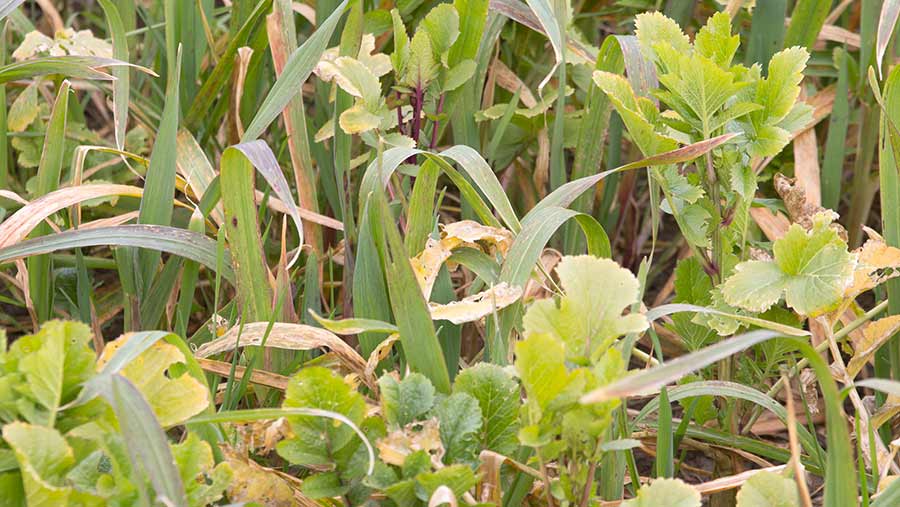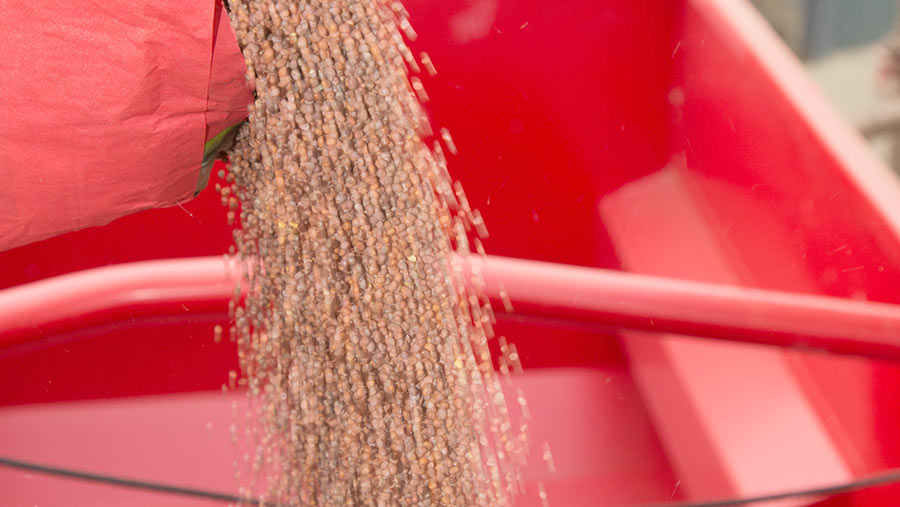How to pick the right cover crop mix this autumn
 © Tim Scrivener
© Tim Scrivener Interest in cover crops in the UK has been on a steep upward trajectory for several years, driven by their ability to right some of the environmental wrongs in cropping systems.
As research money is ploughed into the practice of cover cropping, evidence of these environmental benefits is being reinforced and other bonuses are beginning to emerge, too.
These include yield benefits for following cash crops, with recent findings suggesting a 0.5-0.75t/ha yield boost can be expected in spring and winter cereal crops following the use of cover crops.
See also: Why cover crops have a place on a mixed Hampshire farm
While the environmental and now financial benefits are clear, there is also evidence that cover crops can help with weed and pest control in some situations.
With all these goals and a plethora of seeds available to help achieve them, success starts in selecting the right species or species mix for the chosen role.
Farmers Weekly asks experts at Niab Tag for their latest advice on choosing the right species for the different roles that cover crops fulfil.
1. Nutrient loss
It is now set in stone that cover crops on arable land help to mop up residual nitrogen in the soil, reducing the risk of nitrate leaching into water over the winter by an average of 43%.
Any actively growing plant will deliver this benefit, but non-legume, fast-growing species such as brassicas or oats are best for this purpose.
The nitrogen trapped by the cover crop is then retained in the cropping system to benefit the following cash crops.
2. Soil erosion
During high-risk periods for soil erosion from wind and/or water, actively growing plants play a vital role in holding soils together, preventing losses of soil, sediment, nutrients and pesticides to the natural environment.
Ground cover is crucial when using cover crops for this purpose – as a rule of thumb, once it reaches one third to one half ground cover, erosion risk is significantly reduced and this should be the target when establishing the cover crop.
Mixtures such as oats with brassicas that establish and grow quickly in the autumn serve this purpose best, but if there are other requirements, any mixture should suffice if adequate ground cover is achieved.
3. Managing pests
Plenty of work has been carried out, particularly at Harper Adams University, looking at the use of cover crops for the control of soil-borne pests such as nematodes through either trap cropping or soil biofumigation.
The main species available are typically brassicas with high isothiocyanate levels and species such as Indian mustard, grown over the summer months then macerated and incorporated into the soil. This is thought to be the optimum means of achieving a biofumigation effect.
As biofumigation acts as a soil sterilant, it may help to reduce weed burden, too.
4. Managing weeds
Cover crops are not a major cultural tool for weed control, but they can be used to support an effective integrated weed control strategy in two ways.
First, they offer short-term suppression of weeds to give a clean seed-bed ahead of a crop, for example where chemical weed control options might be limited. Second, they can act as a long-term strategic tool alongside a change in rotation to reduce the overall burden of problem weeds such as blackgrass.
In the long-term approach, cover crops are used together with fallow periods and as a trap crop, allowing weeds to germinate. The cover crop and weeds are then destroyed together before seed is set.
This helps to both deplete the weed seedbank and give the following crop a clean start.
Including cover cropping as part of an all-year fallowing approach to control blackgrass can improve following crop yields through nutrient and soil structure benefits.
Two ways cover crops can help with weed control |
|
|
Trap crops (long term) |
Crop competition (short term) |
|
A cover crop that allows weeds to establish ahead of destruction. |
A cover crop that outcompetes weeds and gives the following crop a clean start. |
|
Cover crop options |
|
|
A wide range can be used, with common mixtures including brassicas, legumes and cereals. |
Brassicas such as radish and mustard offer good ground cover. Buckwheat has been shown to suppress docks. A range of other species can be used. |
|
Extra info |
|
|
Cover crops need to be open to allow weed germination, and starter fertiliser can encourage a better weed flush. |
Good ground cover and destruction is needed. Where the following crop is direct drilled, minimum soil disturbance will give maximum benefit. Not an effective strategy for problem blackgrass. |
5. Building soil fertility and nutrition
Using cover crops to give soils a nutritional boost is the basis of the term “green manure”, and Niab Tag trials have shown that they can provide a rotational yield and a margin over nitrogen dose.
The cover crop also helps stimulate and feed biological activity in the soil and increase worm numbers – a very useful indicator of soil health.
Using cover crops to give soils a nutritional boost |
||
|
Green manure |
Nitrogen (N) boost |
Phosphate (P) boost |
|
A host of species are available that trap N and add organic material to soils. |
Legume species are available to fix N, and most also help to improve soil structure. |
Polygonums are P scavengers and legumes with P cluster rooting can help improve availability. |
|
Options |
||
|
Oats, phacelia, brassicas and legumes. |
A range of legumes such as black medick, clovers, vetches. Fit well into mixtures. |
Potential options are buckwheat and lupins. |
|
Extra info |
||
|
Growth and biomass are important, but consider incorporation issues. Fast-growing species tend to trap more N. |
Early autumn sowing of legumes is required for fixing N. These plants will provide some N for the following crop. |
Buckwheat is better suited to spring sowing, although autumn use is possible in mixtures. Lupins need a pH <7. |
6. Soil structure
A much-vaunted benefit of cover crops is the ability of species with a vigorous and active root system to open soils with their roots and hence improve soil structure – key to the “roots not iron” philosophy of no-till conservation agriculture, but not exclusive to it.
Kellogg’s Origins farmers worked with Niab Tag to assess the role of cover crops and showed that improvements in soil structure (by visual assessment) could be achieved following cover crops.

Radish and other brassicas have multiple benefits as cover crops © Tim Scrivener
This had the benefit of reducing cultivation requirements and also gave a mean yield response of 0.5t/ha in following spring oat crops compared with an over-winter stubble.
The time of cover crop establishment and crop duration, as well as assessing soil structure, potential compaction and its depth, are crucial to determine the correct cover crop species for alleviating the problem.
If there is a strong impediment to rooting in the current crop, a combination of tillage followed by roots might be needed.
Very deep compaction (> 40cm) can be remedied only very slowly and there is currently little research data to confirm the effectiveness of interventions, whether with roots, iron or both.
Species to use to improve soil structure |
|
|
Autumn sowing |
|
|
Where is the main compaction? |
|
|
Shallow (0-20cm) |
Deep (20-40cm) |
|
Cereals, brassicas, legumes and other broad-leaved species are suitable. |
Brassicas and potentially other deep-rooted broad-leaved cover crops are suitable. |
|
Options |
|
|
Oats, phacelia and brassicas such as radish are good choices, but consider mixtures. |
Brassicas such as radish or some mustards, but consider mixtures that include a range of rooting depths. |
|
Extra info |
|
|
Think about soil incorporation conflicts. Brassicas provide useful reduction in nitrate leaching. |
Cover crops may get very bulky for destruction and incorporation. |
|
Spring sowing |
|
|
Where is the main compaction? |
|
|
Shallow (0-20cm) |
Deep (20-40cm) |
|
Cereals, brassicas, legumes and other broad-leaved species are suitable. |
Brassicas and potentially other deep-rooted broad-leaved cover crops are suitable. |
|
Options |
|
|
Cereals such as rye and oats, legumes (trefoil, vetch etc), and broad-leaved crops such as brassicas and phacelia. |
Brassicas such as radish or mustard, but consider mixtures that include a range of rooting depths. |
|
Extra info |
|
|
Think about incorporation, rotational conflicts and crop duration. For spring sown covers don’t forget to consider including pollinator species. |
Consider duration and rooting potential, as well as seed set and volunteer risk. For spring sown covers don’t forget to consider including pollinator species. |
|
Full-season fallow |
|
|
Where is the main compaction? |
|
|
Shallow (0-20cm) |
Deep (20-40cm) |
|
Cereals, brassicas, legumes and other broad-leaved species are suitable. |
Brassicas and some legume species. |
|
Options |
|
|
Oats, legumes such as trefoil and crimson clover, phacelia and brassicas such as radish. Consider mixtures. |
Brassicas such as radish or possibly mustard. Clovers and other deep-rooted species also have potential. |
|
Extra info |
|
|
Legumes can come into their own in longer-duration cover crops and can supply good N fixation inputs to the rotation. |
Research with legumes in this area is limited, but some have shown potential. |

